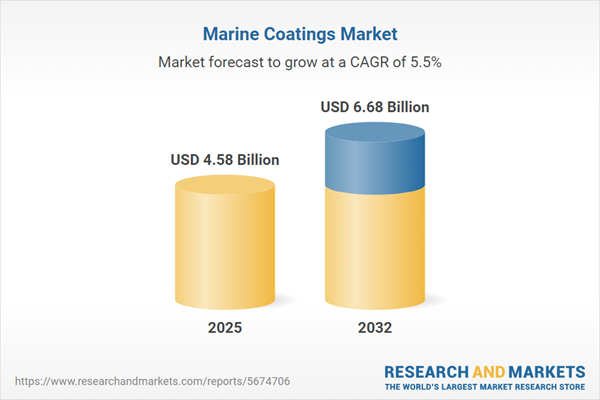Speak directly to the analyst to clarify any post sales queries you may have.
The marine coatings market is undergoing significant transformation as regulatory changes, digital advancements, and evolving procurement standards prompt industry leaders to optimize for long-term operational resilience. Senior decision-makers now prioritize strategies that balance compliance, sustainability, and efficiency to remain competitive amid sector-wide shifts.
Market Snapshot: Marine Coatings Market Growth Trends
The global marine coatings market is currently valued at USD 4.34 billion in 2024. This sector is exhibiting robust and sustained growth, projected to reach USD 6.68 billion by 2032 with a 5.54% compound annual growth rate. Regulatory tightening, higher efficiency standards, and shifts in global shipping routes continue to shape the demand landscape. Companies increasingly seek sustainable coating solutions and adopt digital inspection technologies, both of which help streamline compliance and contribute to higher productivity across maritime operations.
Scope & Segmentation of the Marine Coatings Market
This report equips senior decision-makers with comprehensive guidance for advancing procurement modernization, minimizing operational risk, and aligning investments within the marine coatings market. Coverage spans the following essential segments, each offering specific insight into industry dynamics and procurement challenges:
- Technology: Includes acrylic (solvent- and water-borne), alkyd (long and short oil), epoxy, fluoropolymer, polyurethane (aromatic and aliphatic), and silicone solutions, each developed to improve durability and support environmental objectives.
- Vessel Types: Examines coatings for bulk carriers, container ships, LNG and LPG tankers, roll-on/roll-off vessels, naval craft, and recreational boats, addressing unique compliance and performance requirements across different platforms.
- Coating Types: Covers anti-corrosion coatings, tie coat primers, antifouling and fouling-release technologies, self-polishing options, decorative finishes, and hard modified epoxy, supporting both regulatory and appearance standards.
- End Uses: Focuses on new builds as well as maintenance and repair, emphasizing lifecycle cost management and the need for ongoing operational compliance throughout a vessel’s service life.
- Application Methods: Details brush, roller, and spray techniques designed to enhance workforce efficiency, ensure consistent results, and contribute to cost-effective project management.
- Geographical Regions: Analyzes North America, Latin America, Europe, Middle East & Africa, and Asia-Pacific, with a focus on how fleet profiles and compliance requirements—varying by region—create both opportunities and risks for market players.
- Key Companies: Profiles Jotun A/S, Akzo Nobel N.V., Hempel A/S, PPG Industries, The Sherwin-Williams Company, Chugoku Marine Paints, Nippon Paint Holdings, Kansai Paint, RPM International, and Axalta Coating Systems, assessing their roles in product innovation and supply chain enhancement.
Key Takeaways for Senior Decision-Makers
- Sustainable chemistry is a growing priority, with advancements in materials making it practical to combine environmental responsibility with procurement and compliance goals.
- Digital inspection and monitoring solutions provide pathways for predictive maintenance, improving application consistency and the overall reliability of vessel coating management.
- Cross-industry collaboration involving shipyards, technology partners, and manufacturers strengthens the ability to respond to evolving operational needs and optimize supply chain efficiency.
- As regulatory pressures rise, particularly in sectors like defense, robust and diversified sourcing is essential to mitigate operational and supply chain risks.
- The shift toward bio-based resins is expanding choices for organizations aiming to align sustainability commitments with operational requirements and lifecycle planning.
- Adopting multi-source procurement approaches and reinforcing supplier relationships supports ongoing resilience as the regulatory and compliance landscape changes worldwide.
Tariff Impact on the Marine Coatings Supply Chain
Forthcoming US tariffs on core marine coating raw materials, expected in 2025, present potential challenges across sourcing and cost structures. Senior procurement leaders are advised to intensify risk management, diversify their supplier base, and deploy digital tracking tools to ensure stable access to essential inputs. Enhanced technical support and proactive supplier engagement will help sustain supply chain continuity during periods of policy and tariff adjustment.
Methodology & Data Sources
This report draws on a rigorous combination of leading industry publications, in-depth executive interviews, and insights from established subject matter experts. Analysis is further grounded in regulatory documentation and real-world market data, supporting strategic decisions at the executive level.
Why This Report Matters to B2B Leaders
- Empowers executives to benchmark and evolve marine coatings procurement strategies in line with compliance mandates and digital transformation efforts.
- Supports resilient supplier risk management and sourcing frameworks, especially critical in the face of shifting tariffs and material availability.
- Facilitates anticipation of regional trends and advances in coating technologies, fostering confident investment and procurement planning.
Conclusion
By integrating evolving compliance and sustainability priorities with robust procurement frameworks, senior leaders can enhance operational resilience and sustain competitiveness within the fast-changing marine coatings industry.
Additional Product Information:
- Purchase of this report includes 1 year online access with quarterly updates.
- This report can be updated on request. Please contact our Customer Experience team using the Ask a Question widget on our website.
Table of Contents
3. Executive Summary
4. Market Overview
7. Cumulative Impact of Artificial Intelligence 2025
Companies Mentioned
The companies profiled in this Marine Coatings market report include:- Jotun A/S
- Akzo Nobel N.V.
- Hempel A/S
- PPG Industries, Inc.
- The Sherwin-Williams Company
- Chugoku Marine Paints, Ltd.
- Nippon Paint Holdings Co., Ltd.
- Kansai Paint Co., Ltd.
- RPM International Inc.
- Axalta Coating Systems Ltd
Table Information
| Report Attribute | Details |
|---|---|
| No. of Pages | 184 |
| Published | October 2025 |
| Forecast Period | 2025 - 2032 |
| Estimated Market Value ( USD | $ 4.58 Billion |
| Forecasted Market Value ( USD | $ 6.68 Billion |
| Compound Annual Growth Rate | 5.5% |
| Regions Covered | Global |
| No. of Companies Mentioned | 11 |









